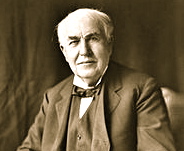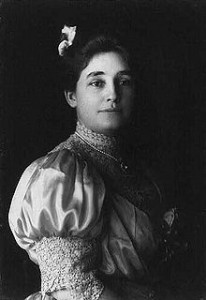Thomas Edison

Thomas Edison Biography
Thomas Edison was an American inventor. Edison invented the phonograph, motion picture camera and long-lasting electric lightbulb. Edison holds over 1000 US patents. Edison developed and distributed electric power to homes and businesses. His contributions became an essential part of modern industrialization that went on to greatly influence the rest of the world. The audio in this biography is public domain and was provided by http://commons.wikimedia.org and Adam Cuerden.
 Thomas Alva Edison (February 11, 1847 – October 18, 1931)
Thomas Alva Edison (February 11, 1847 – October 18, 1931)
He was an American inventorand businessman. He developed many devices that greatly influenced life around the world, including the phonograph, the motion picture camera, and a long-lasting, practical electric light bulb. Dubbed “The Wizard of Menlo Park” by a newspaper reporter, he was one of the first inventors to apply the principles of mass production and large-scale teamwork to the process of invention, and because of that, he is often credited with the creation of the first industrial research laboratory.
Edison is the fourth most prolific inventor in history, holding 1,093 US patents in his name, as well as many patents in the United Kingdom, France, and Germany. He is credited with numerous inventions that contributed to mass communication and, in particular, telecommunications. These included a stock ticker, a mechanical vote recorder, a battery for an electric car, electrical power, recorded music and motion pictures.
His advanced work in these fields was an outgrowth of his early career as a telegraph operator. Edison developed a system of electric-power generation and distribution to homes, businesses, and factories – a crucial development in the modern industrialized world. His first power station was on Pearl Street in Manhattan, New York.
Thomas Edison was born in Milan, Ohio, and grew up in Port Huron, Michigan. He was the seventh and last child of Samuel Ogden Edison, Jr. (1804–96, born in Marshalltown, Nova Scotia, Canada) and Nancy Matthews Elliott (1810–1871, born in Chenango County, New York). His father had to escape from Canada because he took part in the unsuccessful Mackenzie Rebellion of 1837. Edison reported being of Dutch ancestry.
In school, the young Edison’s mind often wandered, and his teacher, the Reverend Engle, was overheard calling him “addled“. This ended Edison’s three months of official schooling. Edison recalled later, “My mother was the making of me. She was so true, so sure of me; and I felt I had something to live for, someone I must not disappoint.” His mother taught him at home. Much of his education came from reading R.G. Parker’s School of Natural Philosophy.
Edison developed hearing problems at an early age. The cause of his deafness has been attributed to a bout of scarlet fever during childhood and recurring untreated middle-ear infections. Around the middle of his career, Edison attributed the hearing impairment to being struck on the ears by a train conductor when his chemical laboratory in a boxcar caught fire and he was thrown off the train in Smiths Creek, Michigan, along with his apparatus and chemicals. In his later years, he modified the story to say the injury occurred when the conductor, in helping him onto a moving train, lifted him by the ears.
Edison’s family moved to Port Huron, Michigan, after the railroad bypassed Milan in 1854 and business declined; his life there was bittersweet. He sold candy and newspapers on trains running from Port Huron to Detroit, and he sold vegetables to supplement his income. He also studied qualitative analysis, and conducted chemical experiments on the train until an accident prohibited further work of the kind.
He obtained the exclusive right to sell newspapers on the road, and, with the aid of four assistants, he set in type and printed theGrand Trunk Herald, which he sold with his other papers. This began Edison’s long streak of entrepreneurial ventures, as he discovered his talents as a businessman. These talents eventually led him to found 14 companies, including General Electric, which is still one of the largest publicly traded companies in the world.
Telegrapher
Edison became a telegraph operator after he saved three-year-old Jimmie MacKenzie from being struck by a runaway train. Jimmie’s father, station agent J.U. MacKenzie of Mount Clemens, Michigan, was so grateful that he trained Edison as a telegraph operator. Edison’s first telegraphy job away from Port Huron was at Stratford Junction, Ontario, on the Grand Trunk Railway.
In 1866, at the age of 19, Edison moved to Louisville, Kentucky, where, as an employee of Western Union, he worked the Associated Press bureau news wire. Edison requested the night shift, which allowed him plenty of time to spend at his two favorite pastimes—reading and experimenting. Eventually, the latter pre-occupation cost him his job. One night in 1867, he was working with a lead–acid battery when he spilled sulfuric acid onto the floor. It ran between the floorboards and onto his boss’s desk below. The next morning Edison was fired.
One of his mentors during those early years was a fellow telegrapher and inventor named Franklin Leonard Pope, who allowed the impoverished youth to live and work in the basement of his Elizabeth, New Jersey home. Some of Edison’s earliest inventions were related to telegraphy, including a stock ticker. His first patent was for the electric vote recorder, (U.S. Patent 90,646), which was granted on June 1, 1869.
Marriages and children
On December 25, 1871, Edison married 16-year-old Mary Stilwell (1855–1884), whom he had met two months earlier; she was an employee at one of his shops. They had three children:
- Marion Estelle Edison (1873–1965), nicknamed “Dot”
- Thomas Alva Edison, Jr. (1876–1935), nicknamed “Dash”
- William Leslie Edison (1878–1937) Inventor, graduate of the Sheffield Scientific School at Yale, 1900.
Mary Edison died at age 29 on August 9, 1884, of unknown causes: possibly from a brain tumor or a morphine overdose. Doctors frequently prescribed morphine to women in those years to treat a variety of causes, and researchers believe that some of her symptoms sounded as if they were associated with morphine poisoning.
On February 24, 1886, at the age of thirty-nine, Edison married the 20-year-old Mina Miller (1866–1947) in Akron, Ohio. She was the daughter of the inventor Lewis Miller, co-founder of the Chautauqua Institution and a benefactor of Methodist charities. They also had three children together:
- Madeleine Edison (1888–1979), who married John Eyre Sloane.
- Charles Edison (1890–1969), who took over the company upon his father’s death and who later was elected Governor of New Jersey. He also took charge of his father’s experimental laboratories in West Orange.
- Theodore Edison (1898–1992), (MIT Physics 1923), credited with more than 80 patents. Mina outlived Thomas Edison, dying on August 24, 1947.
http://en.wikipedia.org/wiki/Thomas_Edison



